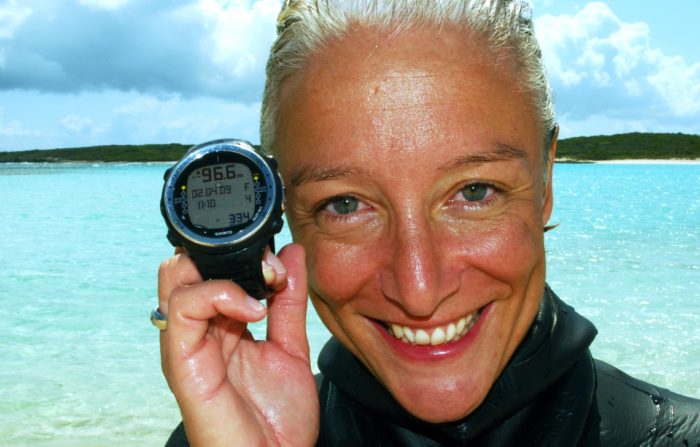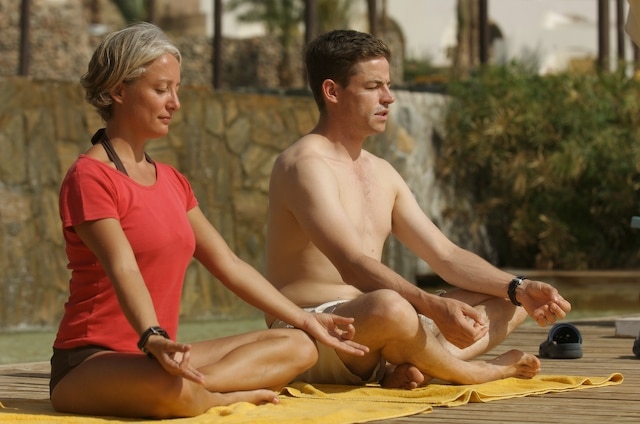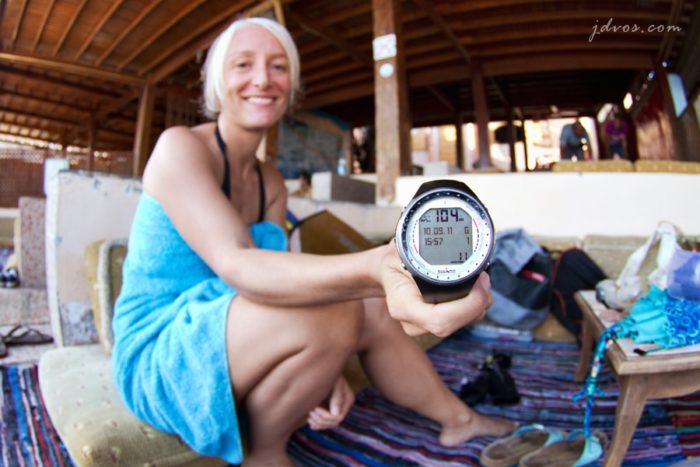As freedivers, we are always seeking ways to make ourselves better at our sport. Whether one is new to the sport of freediving, a spearo looking to increase bottom time, or a world champion, adding the right training and developing the right mindset will provide tremendous benefits.
SIGN UP TODAY via www.yogaforfreediving.com
DeeperBlue.com recently had the opportunity to review the first section of Yoga for Freediving, a comprehensive and intriguing course designed by Sara Campbell, 4-time Freediving World Record holder. Relaxation is the first of six courses that are being launched, and is itself comprised of six videos. The courses that will be in the series are:
- Relaxation (This Review)
- Training and Performance
- Manage your Mind
- Success and Failure
- Limitless Energy
- Pre-dive Preparation
While Yoga has been an ubiquitous part of the culture since the mid 1960’s, most of us probably don’t have much experience in the practice of Yoga. From it’s roots in Western culture as something exotic practiced by obscure Gurus, Hippies and the Beetles, Yoga has become a significant force in the Health and Wellness arena…and more and more world-class athletes are incorporating Yoga into their training.
Freedivers are increasingly familiar with the close relationship that exists between Yoga and our sport. Many of us remember the scene from The Big Blue where the character of Enzo Molinari is complaining to Jacques Mayol’s character about all the time he spends meditating. Like the fictional character in the movie, the real Jacques Mayol, one of the pioneers of our sport, introduced Yoga to freediving in the 1960’s and virtually all world-class freedivers practice Yoga to some degree in their preparations. Mayol was an avid practitioner of the Pranayama element of Yoga, which is the fourth “limb” of the eight limbs of Ashtanga Yoga. This style, or school of Yoga, has introduced many Westerners to the philosophy and practice of Yoga specifically concerned with breath control.

Sara Campbell is the founder of Discover Your Depths, “a unique teaching and personal growth philosophy based on yoga, meditation, freediving and mind-body awareness.” Sara teaches Kundalini Yoga and has developed a training program that can give students a foundation for increased personal growth and personal performance in daily activities and in freediving.
“As well as coaching freedivers to safely achieve greater depths through a deeper understanding of the vital mind-body connection, I use freediving, yoga and meditation as metaphors for life and tools for change.” Sara Campbell
Sara’s video series Yoga for Freediving introduces the knowledge her students learn in class to the internet, and gives freedivers the opportunity to learn at their own pace, mastering the 6 core videos as they gain in knowledge.
On initial review, it becomes immediately apparent that this is a “Master Class” in some respects. There are a lot of terms and concepts that are presented that may be unfamiliar to the average freediver. As most of these terms are defined within the body of the videos, and in the copious explanatory sections, this is not a big issue, but could be intimidating to someone who has no exposure to Yoga and Eastern spiritual philosophy. The viewer should take the time to watch the entire video, remaining open to new ideas and concepts, and not worry about having to do a research paper on the topics discussed… the practice of Yoga encompasses words and ideas from almost 3,000 years of Eastern Philosophy. We will attempt to define some of these terms throughout the review.

Yoga describes a spiritual, physical and mental practice that originated around the 6th century BCE in India. Yoga is one of the oldest of the world’s spiritual systems and encompasses numerous styles and philosophies. Yoga is a combination of meditative practices, physical exercises and discipline structures that are designed to empower the Human Mind, Body and Spirit as a whole. As mentioned, Jacques Mayol was a practitioner of a style in Ashtanga Yoga called Pranayama, while Sara Campbell teaches Kundalini Yoga. The emphasis in Kundalini Yoga is on breathing in conjunction with physical movement. Practitioners believe that Kundalini Yoga frees energy in the lower body and base of the spine, allowing it to move upwards. Kundalini also explores the effects of the breath (also called prana, meaning energy) on posture and position.
Sara Campbell explains that “Yoga for Freediving includes two hours of expert yoga-based exercises and advice.” In addition, she has included a further two hours of tips and techniques in 22 ‘HOW TO’ videos, a valuable reference guide that will be part of each of the six courses. These bonus materials can be crucial for creating your own meditation practice, and mastering the yogic techniques used in freediving and throughout this program.
“Relaxation is quite possibly the most important aspect of freediving, but unlike equalization and other physical techniques, relaxation is a state of mind, and is harder to learn.”
“When you first start learning to freedive, relaxation is hard because everything is so new and there is so much to integrate; as you get deeper and start exploring your limits, relaxation is hard because you start coming up against very real mental and physical challenges. But without effective relaxation, it is impossible to progress no matter what level you are.”
The series begins with the first lecture in the series: ONG NAMO is where Sara introduces the viewer to the Adi Mantra. Adi means the first, or primal, and is intended to center the practitioner and bring them into focus before meditation or Yoga.
The words “Ong Namo Guru Dev Namo” form what is called a “Mantra”, an ancient Sanskrit word that means “Instrument of Thought”. Mantras are considered to be a “sacred sound”…represented by a syllable, word, phonemes, or group of words. Yoga practitioners believe that Mantras have both spiritual and physiological power and serve as a key to unlock the physical, psychological and spiritual person.
Sara explains to the viewer that “This is the first lecture I delivery to any student. It is also one of the most powerful lessons we can learn in our freediving.” It is important to understand that this video is unique in the thorough mental aspect of the training. Sara also wants students to understand that “this is not a quick-fix” and that benefits are realized through regular practice.
Set in an intimate environment, with Sara facing the students in a comfortable Yoga pose, this video gives us an introduction to the Mantra and Sara’s philosophical views regarding Yoga and how we can incorporate the practice into our daily lives and into freediving.
“We tend to dive in the same way that we approach life; that the harder we try, the more chance we have of succeeding. Changing this approach – to one of trust, complete relaxation and surrender – is the key to reaching your goals, but is often one of the most hardest, most painful and frustrating lessons to learn.” As Sara puts it, “The sooner you start, the sooner you can let go of your fear, your stress and begin to enjoy blissful dives that feel easier than ever before.”
Learn to Meditate is the second video in the series. The video is a good foundation for those of us who have never meditated before. As a freediver, this module will teach you that you can control and discipline your mind…”harness that power and use it for yourself”, as Sara states in the video. The viewer will practice meditating along with Sara, and hear the invocation of Ong Namo Guru Dev Namo as it applies to meditation.

Dahab. Egypt. Photo Credit Dan Burton
Sat Nam (Sat Naam) are the primary words that appears in Sikh sacred scripture Granth Sahib. Sat Nam is the principle Mantra in Kundalini Yoga , based on Tantric texts and theories and Sikh traditions. Most practitioners define the words Sat as Truth and Nam as Name or Self. A simple translation would be “Truth is my name“. As a greeting, saying “Sat Nam” is akin to saying “I see your true nature” or “I recognize the divinity within you”.
The viewer will learn that every action “is the result of a thought, whether we are conscious of it or not. If we want to change the outcome of our actions, in this case, improve our dive performance…learning to meditate is simple, and even short times sitting can pay huge benefits, if the practice is regular.”
The third video on the series is Pranayama: One Minute Breath and discusses the Pranayama elements of Yoga, which will be familiar to freedivers who are familiar with Jacques Mayol’s practice of this form. This video introduces the viewer to using Yoga to control one’s breathing, find a sate of mental “quiet” and relaxation. Sara will take you through a series of breathing exercises and short, powerful breath holds. The viewer will hear more complex Mantras, but Sara explains that the viewer should just listen, there is no expectation that you repeat the Mantras verbatim.
In order to practice this exercise ourselves, we downloaded a “Meditation Timer” App from the iTunes Store as suggested by Sara in the video. There are a number of Apps on the iTunes Store that will aid your meditation practice.
We found that the exercise, when done correctly, takes work! Deliberate concentration and focus on the actual parts of the breath, controlling the body’s physiological impulses and staying “in control” of one’s breathing are just a few of the skills you will gain from this video.
“This pranayama is the most powerful stress-busting exercise you can do. It will also train your mind to focus, your heart to trust and will extend your breathhold! Seriously! All that in one exercise.”

The fourth video in the series is second of the two “Lectures”. In this one, Sara examines Trust and Surrender, and the roles that these two concepts play in our ability to dive deeper and longer. She is quick to illustrate that “technique” is not the thing that takes the diver to the bottom plate and back to the surface safely. She illustrates that the Dive Response, the physiological mechanisms of the body to make that dive have to be Trusted. Sara talks in depth regarding bringing trust and surrender into your dive to allow yourself to release the stress and “handing over the responsibility of a major part of your dive to the dive response”
“Trust and surrender are key concepts in great, safe, deep dives. It’s easy to talk about them, but really getting yourself to a place where you embody them in your dives, is much harder…We all know that in order to dive deep we need to confront and let go of our ego. If we can trust that we are meant to freedive, that our bodies contain wisdom that allows us to dive already, and that we can surrender to this wisdom and simply enjoy the ride, we find that deep dives become easy and effortless.”
The fifth video in the series is titled Visualization: Isolated Contraction, which teaches the viewer how to stay relaxed while engaging specific muscles in rigorous physical activity. For example, we want our chest to stay “soft” while finning, but exert maximum effort from our legs and core. This module is a demonstration and participation module, which takes the viewer through the exercises.
“Relaxation is such a crucial part of freediving, we need to learn to be as relaxed as possible throughout our body even though some parts of it are working physically and will be contracted.”
Through the process of using Yoga and controlled, Pranayama breathing exercises, we can “improve your body awareness, which is key to being able to isolate ONLY the muscles that need to be contracted at any given moment during a dive, and ensure the rest of your body is completely relaxed.”
Critical to freediving is the ability to lessen the impact from the diaphragm contractions that come when our breathing reflex kicks in.
The last video is another guided Meditation. To Know the Field is specific to competition mindset and preparing ourselves mentally to be fully relaxed, fully engaged, and visualizing those things in our training and regiment that worked for us…and being mentally “in the game”. This is a two-part exercise to help the diver counteract “mental self-sabotage” to bring us to goal realization.
When a four-time World Record Holder suggests that by trusting our body and our spirit we can “let these dives unfold” and that the depths we want to reach are “within our capability”, there is a great deal of credibility that by getting in touch with, or tapping, our Kundalini Energy (our Life Force), we can visualize our success and therefore be successful.

So, with all six videos viewed and exercises completed, we found ourselves deeply impressed with the detailed presentation. The advantages to incorporating Yoga into our freediving training is amply demonstrated by Sara Campbell and we found that the videos were sharp, professional and clear in the delivery of the content.
The hardest part of the series was overcoming our own biases and lack of understanding about Yoga and Meditation. Our initial reaction was to exclaim “this isn’t for everyone”, but that would be like saying “exercise isn’t for everyone”. As mentioned earlier, the viewer may feel intimidated or unable to focus on the message by getting bogged down in the details. This is not about learning how to stretch, or what kind of diet freedivers should be doing…but the concepts that are presented here will benefit ANY level of freediver. Part of learning to relax and not be stressed is to open up to new concepts and “go with the flow”.
“These videos give you practical tools to learn how to relax – meditations, pranayama (breathing exercises), lectures and a guided visualization – to help you actively tackle the different aspects of relaxation; how to beat stress, relax your body, and understand and manage your mind.” Sara Campbell
After completing the series, we believe that the novice freediver will gain an incredible depth of information and knowledge about techniques being used by numerous world champions past and present. Spearos will improve their hypoxic and hypercapnic tolerances, increasing their relaxation and comfort in the water and their depth and duration on their dives. The competitive athlete will become more so…and perhaps unlock the skills and energy to compete at the highest levels of our sport.
The concepts incorporated in this video series are obviously geared to the freediver, but they are equally applicable to anyone who wants to improve their mental, spiritual and physical balance and gain deeper understanding of how the Mind, Body and Spirit are all connected.
At a cost of only $50.00 (USD), this is an incredible set of tools that every freediver should add to their training regimen. The videos are made available as streaming media and as Mp3 downloads so you can watch them again and again on your iPhone, tablet or laptop. We highly recommend this series and the first installment Relaxation promises the rest will be outstanding!
“Sat Nam”
SIGN UP TODAY via www.yogaforfreediving.com
More About This Course
- Features:
- six videos and over two hours of expert, targeted RELAXATION training
- a further two hours of tips and technique training in 22 HOW TO videos
- video streaming on any mobile device
- audio downloads of the lectures and visualizations to take with you wherever you want
- step by step program guidelines to ensure you get the best out of your RELAXATION experience
- PRICE: $50 USD
- Available from www.yogaforfreediving.com

